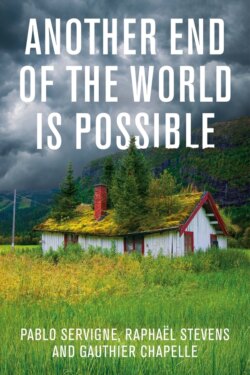Читать книгу Another End of the World is Possible - Pablo Servigne - Страница 13
A branch of collapsology directed towards inner experience
ОглавлениеAfter we put together the facts about a possible collapse in a first book (How Everything Can Collapse: A Manual for Our Times),18 we can see several directions that are open for ‘collapsologists’ who want to move onwards. The most important, it seems to us (though not the most urgent one), is that of collective action, in other words of developing realistic, bold and courageous political proposals. However, before we act, and even before we propose courses of action, there are still things we need to understand and an inner journey we need to make. That journey involves coming to terms with the psychological aspects of climate change or other global disasters.19
Here we face a huge challenge. Even to be interested in these subjects in their scientific or sociological forms brings with it some risk for our mental health. As for people who take this question head-on and make it the central direction of their lives, they are confronted (and will be for a long time) with very strong demands, both psychological and in their relations with others, as well as in their social and political commitments.
Those who have thought about how bad the situation might get ‘will not have an easy time coping with it, but they are not as apt to be overwhelmed by it as those who refuse to contemplate it’. 20 Between the person who is ready for action and the one who remains in denial, there is a whole range of people with various problems: those who just live through catastrophic events at a physical level, those who feel that something is wrong but cannot find the words for it (weak cognitive dissonance), those who know but cannot act in the way that they would wish (acute cognitive dissonance), and those who know and act but are exhausted or discouraged.
During these years of discussions with the public, we arrived at the same conclusion as that described by Carolyn Baker, who has accompanied many people struggling with the prospect of collapse: once the penny drops, most people don’t want to see more and more evidence (even if it was important to begin with); they want above all to learn how to live with the collapse. They become ‘collapsonauts’.
So, preparing oneself for this future does not just involve material and political aspects. It also has psychological, spiritual, metaphysical and artistic dimensions. The questions which the disasters pose for us are difficult to come to terms with. If we want to continue thinking about the collapse, if we seek to act, to make sense of our lives, or just to get up in the morning, it is important not to go crazy. Crazy with isolation, crazy with sadness, crazy with rage, crazy from thinking too much about it, or crazy from continuing one’s little routines while pretending not to see.
Some people think of this psychological dimension as a matter for women, or as a luxury reserved for fragile city dwellers who have known nothing but comfort. It’s not like this at all. The psychological challenge is a primordial one, and it affects all social classes, all peoples, all cultures. What do we say to the Sudanese refugee who suffers from anxiety or post-traumatic stress in a camp in Libya or in Calais? That his suffering is negligible? What do we say to the family of a young hyper-sensitive Belgian student who commits suicide because he has seen too much? How do we help the engineer in charge of oil-well drilling, who is reluctant to return to work every morning after kissing his children? How can you keep your spirits up as an activist trying to block a development project, when you create new ways of living in the territory you are defending, and you get bulldozers and grenades in reply?
The purpose of collapsology is not to state certainties that will crush any possible future, nor to make precise predictions, nor to find ‘solutions’ that can ‘avoid a problem’, but to learn to live with the bad news and with the changes that they foretell, sudden or gradual, so that we can find the strength and the courage to do something that will transform us, or, as Edgar Morin would say, will bring about our metamorphosis.
